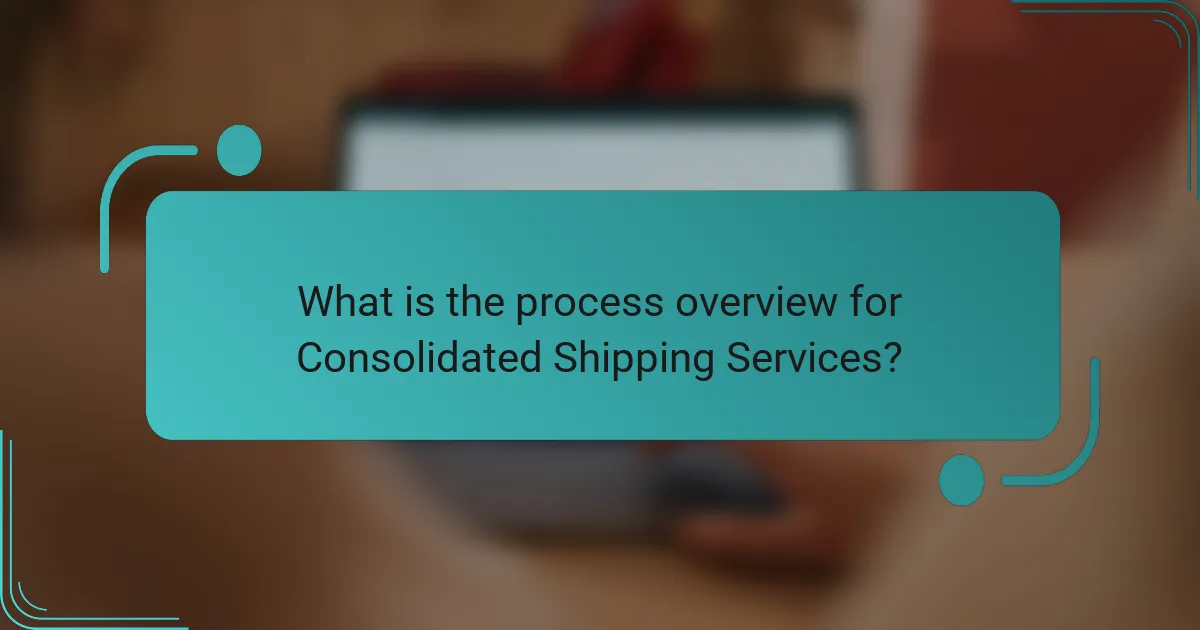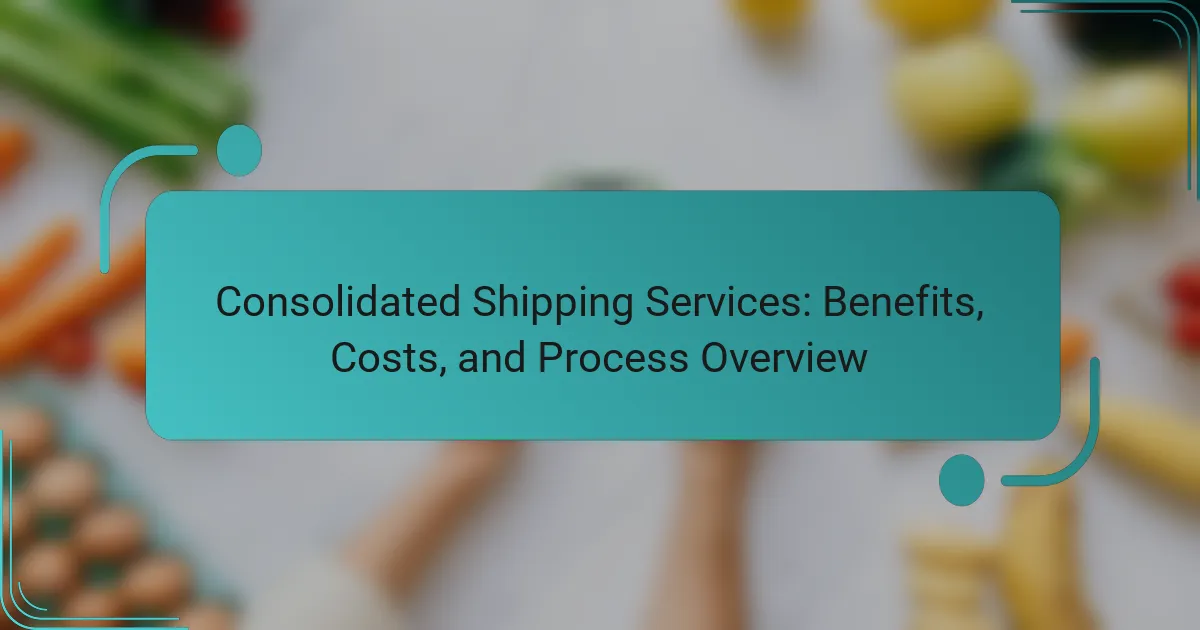
What are Consolidated Shipping Services?
Consolidated shipping services involve the grouping of multiple shipments into one larger shipment. This method reduces shipping costs by maximizing space and efficiency. Businesses often use these services to save money on transportation. Consolidated shipping also streamlines the logistics process. It allows for easier tracking of multiple packages. The process typically involves a freight forwarder or logistics company. They handle the collection and consolidation of goods. This service is beneficial for companies with smaller shipments. It ensures timely delivery while minimizing expenses.
How do Consolidated Shipping Services operate?
Consolidated shipping services operate by combining multiple shipments into a single transport unit. This process reduces shipping costs and improves efficiency. Companies collect goods from various clients and consolidate them at a central location. Once consolidated, the shipments are sent together to the destination. This method maximizes cargo space and minimizes transportation expenses. Tracking systems are often used to monitor the consolidated shipments. By sharing transportation resources, businesses can lower their overall shipping costs. This approach is especially beneficial for small to medium-sized enterprises.
What are the key components of the Consolidated Shipping process?
The key components of the Consolidated Shipping process include cargo consolidation, documentation, transportation, and distribution. Cargo consolidation involves grouping multiple shipments into one larger load to optimize space and reduce costs. Documentation is crucial for ensuring compliance with regulations and includes bills of lading and customs paperwork. Transportation refers to the movement of consolidated cargo, which can involve various modes such as trucking, shipping, or air freight. Finally, distribution is the process of delivering the consolidated cargo to its final destination, ensuring timely and efficient delivery. These components work together to enhance efficiency and cost-effectiveness in shipping operations.
How does the consolidation of shipments work?
Consolidation of shipments involves combining multiple smaller shipments into one larger shipment. This process reduces shipping costs and improves efficiency. Shipping companies collect goods from various suppliers. They store these goods until they have enough volume to fill a container or truck. Once the container or truck is full, the consolidated shipment is sent to its destination. This method minimizes the number of trips needed for delivery. It also optimizes space and reduces fuel consumption. Statistics show that consolidated shipping can lower transportation costs by up to 30%. This efficiency benefits both shippers and carriers.
What are the benefits of using Consolidated Shipping Services?
Consolidated shipping services offer cost savings, efficiency, and simplified logistics. They allow businesses to share container space, reducing shipping costs significantly. This method lowers overall freight expenses by combining smaller shipments into one larger shipment. Consolidated shipping also decreases transit times by optimizing routes and schedules. It simplifies customs clearance as fewer shipments mean less paperwork. Additionally, it enhances tracking and visibility of shipments. Businesses can benefit from improved inventory management through better scheduling. Overall, these services streamline the shipping process, making it more efficient and cost-effective.
How do Consolidated Shipping Services reduce shipping costs?
Consolidated Shipping Services reduce shipping costs by combining multiple shipments into one. This method allows for economies of scale. By consolidating, companies can share transportation costs. This leads to lower rates per shipment. Additionally, it minimizes the number of trips needed. Fewer trips mean reduced fuel costs and labor expenses. Consolidated services also optimize route planning. Efficient routing further decreases overall shipping time and costs.
What advantages do businesses gain from using Consolidated Shipping?
Businesses gain several advantages from using Consolidated Shipping. This shipping method reduces costs by combining multiple shipments into one. It allows businesses to save on transportation expenses. Consolidated Shipping also improves efficiency by optimizing delivery routes. This leads to faster transit times and reduced fuel consumption. Additionally, it minimizes the risk of delays by consolidating shipments to meet specific schedules. Businesses can also benefit from better inventory management through more predictable delivery patterns. Overall, Consolidated Shipping enhances operational effectiveness and lowers shipping costs.

What are the costs associated with Consolidated Shipping Services?
The costs associated with Consolidated Shipping Services include shipping fees, handling charges, and customs duties. Shipping fees are typically based on the weight and volume of the shipment. Handling charges cover the labor involved in loading and unloading cargo. Customs duties apply to international shipments and vary by destination and shipment value. Additional costs may include insurance, storage fees, and fuel surcharges. For example, fuel surcharges can fluctuate based on current fuel prices. Understanding these costs is essential for budgeting and planning shipments effectively.
What factors influence the pricing of Consolidated Shipping Services?
The pricing of Consolidated Shipping Services is influenced by several key factors. These factors include the volume of goods being shipped, the distance of transportation, and the type of cargo. Additionally, service level requirements, such as speed and handling needs, also play a significant role. Seasonal demand fluctuations can affect pricing as well. Lastly, fuel costs and regulatory fees contribute to the overall pricing structure. Each of these elements impacts the final cost charged to customers for shipping services.
How do volume and weight affect shipping costs?
Volume and weight significantly affect shipping costs. Shipping companies typically charge based on the greater of the actual weight or dimensional weight. Dimensional weight is calculated by multiplying the package’s volume by a dimensional factor, often around 166 for domestic shipments. This means larger but lighter packages can incur higher costs than smaller, heavier ones. For example, a package measuring 12x12x12 inches may have a dimensional weight of 12 pounds, which could exceed its actual weight. Thus, both volume and weight influence the final shipping price, impacting overall shipping expenses for businesses and consumers.
What additional fees should businesses be aware of?
Businesses should be aware of several additional fees associated with consolidated shipping services. These fees can include customs duties, which are taxes imposed on imported goods. Handling fees may also apply, covering the costs of processing shipments at distribution centers. Storage fees can arise if goods are held for an extended period before delivery. Fuel surcharges are common, reflecting fluctuations in fuel prices that impact shipping costs. Insurance fees may be necessary to protect against loss or damage during transit. Finally, there may be administrative fees for paperwork and compliance with regulations. Understanding these fees helps businesses budget effectively for shipping expenses.
How can businesses estimate the costs of Consolidated Shipping?
Businesses can estimate the costs of consolidated shipping by analyzing various factors. Key factors include the total weight and volume of the shipment. Businesses should also consider the distance to the destination. Shipping rates are often based on these metrics. Additionally, they should account for any fees associated with customs and tariffs. Businesses can use shipping calculators provided by carriers for accurate estimates. Comparing rates from multiple carriers can also provide insights into cost variations. Finally, understanding the frequency of shipments can help in negotiating better rates with carriers.
What tools are available for cost estimation?
Cost estimation tools include software and methodologies that help calculate project expenses. Common tools are Microsoft Excel, which allows for customizable spreadsheets and formulas. Project management software like Primavera P6 offers integrated cost estimation features. Estimating software such as ProEst provides templates and industry-specific data. Construction-specific tools like Sage Estimating are designed for detailed project costs. Additionally, online calculators and databases can provide quick cost references. These tools help improve accuracy and efficiency in budgeting for shipping services.
How do shipping rates vary between providers?
Shipping rates vary significantly between providers based on several factors. These factors include the type of service selected, distance, package weight, and dimensions. Different providers may offer varying rates for standard, expedited, or overnight shipping. For instance, FedEx and UPS have distinct pricing structures that can affect total shipping costs. Additionally, regional carriers may provide more competitive rates for local deliveries compared to national providers. Discounts for bulk shipping or frequent shipping can also differ among companies. According to a 2022 study by Pitney Bowes, shipping costs can vary by up to 30% based on the chosen provider and service level.

What is the process overview for Consolidated Shipping Services?
Consolidated Shipping Services involves a systematic approach to managing freight. The process begins with the collection of cargo from various suppliers. After collection, the cargo is consolidated into larger shipments. This reduces shipping costs and improves efficiency. Next, the consolidated cargo is transported to a central hub. At the hub, the cargo undergoes sorting and documentation checks. Once sorted, the cargo is dispatched to its final destination. Throughout the process, tracking systems monitor the shipment’s progress. This ensures transparency and timely delivery.
What are the steps involved in the Consolidated Shipping process?
The steps involved in the Consolidated Shipping process include several key phases. First, goods are collected from various suppliers. This step ensures that items are gathered in one location for shipping. Next, the collected goods are sorted based on destination and type. Sorting is crucial for efficient transportation. After sorting, the items are packed into containers for shipment. Proper packing protects the goods during transit. Following packing, the containers are loaded onto a transport vehicle, such as a truck or ship. This loading process is essential for moving goods to their next destination. Finally, the shipment is tracked until it reaches the final destination. Tracking ensures visibility and accountability throughout the shipping process.
How does the booking process work?
The booking process for consolidated shipping services involves several key steps. First, customers submit a booking request through an online platform or by contacting a service representative. Next, the service provider confirms the availability of space and provides a quote based on the shipment details. Once the customer accepts the quote, they need to provide necessary documentation, such as invoices and shipping labels. After documentation is submitted, the service provider schedules the pickup or drop-off of the shipment. Finally, customers receive tracking information to monitor their shipment’s progress. This systematic approach ensures efficient handling and timely delivery of goods.
What happens during the loading and transport phases?
During the loading phase, cargo is organized and secured onto transport vehicles. This involves verifying the shipment details and ensuring proper weight distribution. Workers use equipment like forklifts for efficient loading.
In the transport phase, the loaded cargo is moved to its destination. Transportation can occur via road, rail, sea, or air. Tracking systems monitor the shipment’s progress in real time.
Both phases ensure that goods are handled safely and arrive on time. Proper loading techniques reduce the risk of damage during transport.
What documentation is required for Consolidated Shipping?
Consolidated shipping requires specific documentation. The essential documents include a bill of lading, which serves as a receipt and contract. A commercial invoice is also needed to detail the goods being shipped. Additionally, a packing list outlines the contents of each package. Customs declaration forms are necessary for international shipments to comply with regulations. Lastly, any required export licenses must be obtained for specific goods. These documents ensure smooth processing and compliance with shipping regulations.
What are the essential documents needed for shipping consolidation?
The essential documents needed for shipping consolidation include a bill of lading, commercial invoice, packing list, and export declaration. The bill of lading serves as a contract between the shipper and carrier. It details the type and quantity of goods being shipped. The commercial invoice provides a record of the sale and includes information about the buyer and seller. The packing list outlines the contents of the shipment, including weights and dimensions. The export declaration is required for customs clearance and provides details about the shipment’s destination and value. These documents ensure compliance with regulations and facilitate smooth transportation.
How can businesses ensure compliance with shipping regulations?
Businesses can ensure compliance with shipping regulations by staying informed about applicable laws. Regularly reviewing federal, state, and international shipping regulations is essential. Implementing a compliance management system helps track regulatory changes. Training employees on shipping procedures and regulations is crucial. Utilizing technology, such as compliance software, can streamline this process. Conducting regular audits ensures adherence to shipping standards. Collaborating with legal experts can provide additional guidance. Maintaining accurate documentation supports compliance efforts and reduces risks.
What best practices should businesses follow when using Consolidated Shipping Services?
Businesses should follow several best practices when using consolidated shipping services. First, they should accurately assess their shipping needs. This includes understanding volume, frequency, and destination of shipments. Next, they must choose a reliable shipping partner with a proven track record. Researching customer reviews and service history can provide insights into reliability.
Additionally, businesses should optimize their packaging. Proper packaging can reduce damage during transit and maximize space efficiency. They should also consolidate shipments effectively. Combining multiple orders into one shipment can reduce costs and improve delivery times.
Communication is crucial. Keeping open lines with the shipping provider ensures timely updates on shipment status. Finally, businesses should regularly review shipping performance. Analyzing costs and delivery times can highlight areas for improvement. Following these best practices can enhance the efficiency of consolidated shipping services.
How can businesses optimize their shipping schedules?
Businesses can optimize their shipping schedules by implementing advanced logistics software. This software enhances route planning and delivery tracking. It allows for real-time updates and adjustments to schedules. By analyzing historical shipping data, businesses can identify peak times and adjust accordingly. Utilizing predictive analytics can forecast demand and optimize inventory levels. Collaboration with carriers can lead to better rate negotiations and service options. Implementing a just-in-time inventory system reduces excess stock and storage costs. Regularly reviewing and adjusting shipping strategies ensures continued efficiency.
What common pitfalls should be avoided in the Consolidated Shipping process?
Common pitfalls in the Consolidated Shipping process include poor communication, inaccurate documentation, and inadequate planning. Poor communication can lead to misunderstandings about shipment details. Inaccurate documentation may result in delays and additional costs. Inadequate planning often causes missed deadlines and inefficient resource allocation. Additionally, failing to comply with regulations can lead to legal issues. Overlooking cargo insurance can expose businesses to financial risks. Lastly, neglecting to track shipments can result in lost or misplaced items. Each of these pitfalls can significantly impact the efficiency and effectiveness of the shipping process.
Consolidated Shipping Services involve the grouping of multiple shipments into a single larger shipment to optimize costs and efficiency. This article covers the operational process of consolidated shipping, including key components such as cargo consolidation, documentation, and transportation. It highlights the benefits, including cost savings and improved logistics, as well as the factors influencing pricing and additional fees businesses should consider. Additionally, the article outlines best practices for optimizing shipping schedules and avoiding common pitfalls in the consolidated shipping process.
